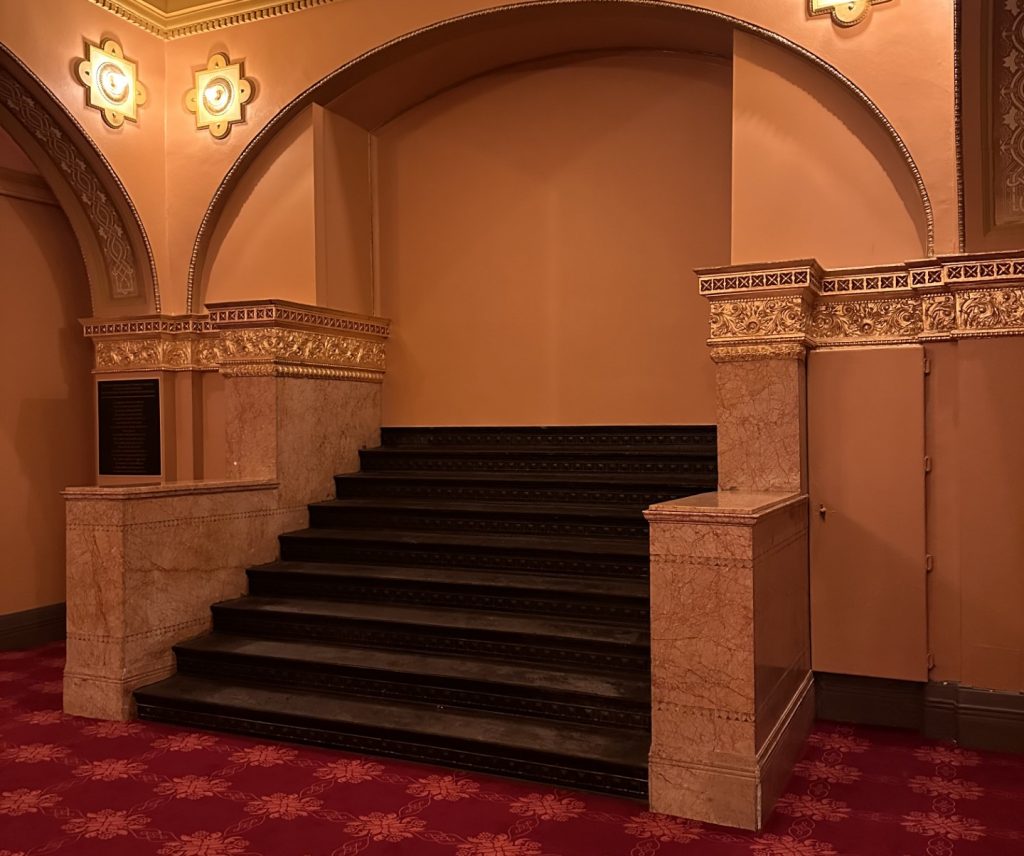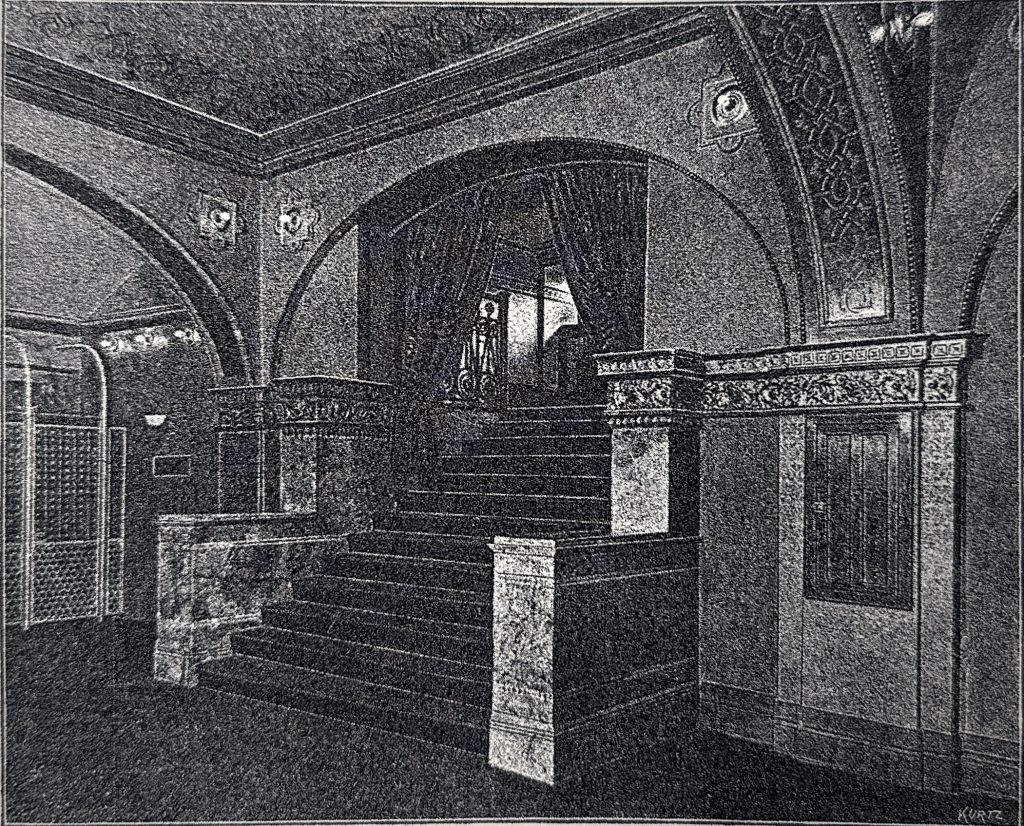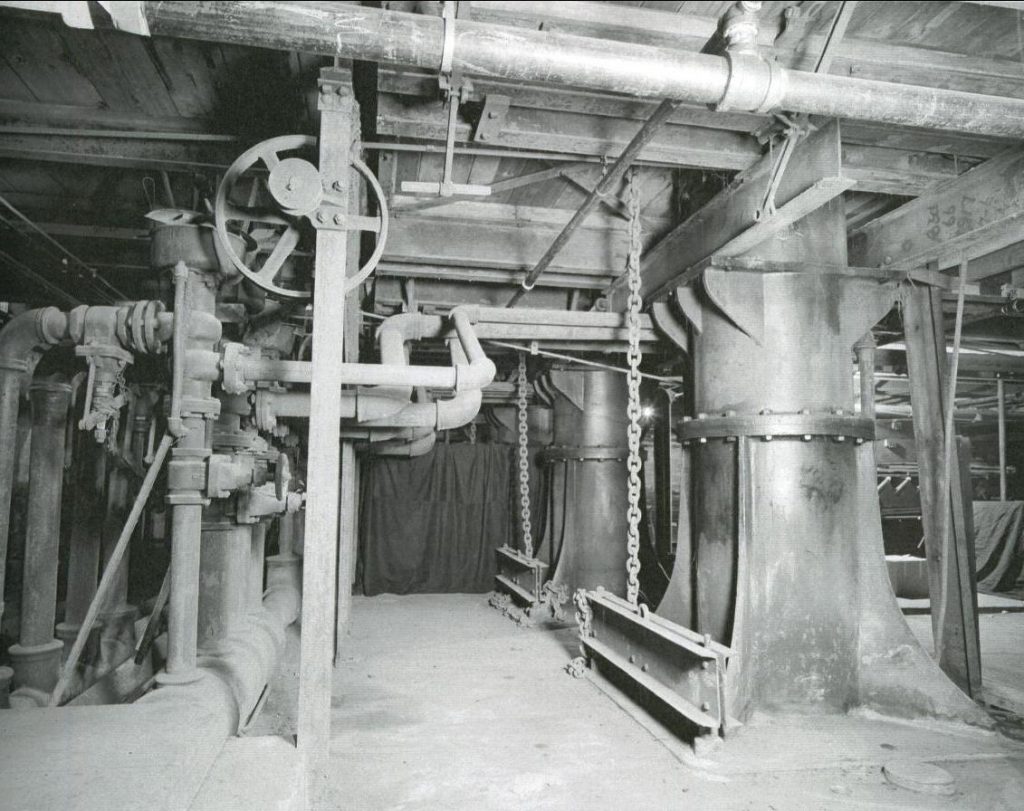
Have you ever noticed the set of stairs located on the second floor? It’s different from every other staircase in the building because it leads right into a wall. Don’t worry, the Auditorium isn’t another Winchester Mystery House. Those stairs used to lead to the Ladies Room!
“The men have a smoking room, and the ladies have their own foyer — exclusively theirs, which the tyrant man dare not invade. If he ventures to ascend the steps, a gentle mannered young lady attendant glides in front of him and murmurs that it is exclusively for ladies, and he retires.”(1)

Second floor Stairs to Nowhere. Current.

Second floor Stairs to Nowhere. Before.

Second floor Stairs to Nowhere. Inside.
For the first 50 years of the Auditorium, the theatre lived up to Ferdinand Peck’s purpose and expectations as the home for Opera in Chicago. Opera companies from around the world flocked to the city to perform on our stage. The same was true for orchestras, ballets, and other touring artists such as the New York Metropolitan Opera who regularly performed throughout the next decade under the gilded arches. Some of the most well-recognized works in the opera repertoire were presented such as Giacomo Puccini’sTosca, Giacomo Meyerbeer’s Les Huguenots, Georges Bizet’sCarmen, and so much more.
The Auditorium became a popular venue because of not only its perfect acoustics, but also its stage apparatus. The theatre’s design allowed the venue to change in size, shape, and purpose, making it an extremely versatile space. Here are the elements that make the Auditorium so flexible:
A solid reducing curtain made from iron and plaster was designed to be raised or lowered to alter the size of the stage’s proscenium opening. For full operas and large events, the reducing curtain was lifted to allow the performers to use the full stage width of 75ft (about half as tall as The Chicago Water Tower!). For smaller productions and events, such as lectures and concerts, the reducing curtain was lowered to narrow the stage opening to 47ft wide x 35ft high. The reducing curtain face panels are decorated with intricate organic designs and contain the names of ten famous composers.
Part of the parquet, also known as orchestra level (the area closest to the stage), could be covered with temporary floors to transform the theatre into the city’s largest ballroom. Small cast iron footings (still visible today) were located across the floor to hold vertical poles that supported the temporary floor above the seats. This floor system allowed the theatre to be used as a ballroom or a banquet hall, as well as a space for indoor softball games, tennis matches, and more.

Auditorium Theatre converted into a banquet hall using temporary flooring.
In 1889, twenty-six hydraulic lifts were located beneath the Auditorium’s stage. This modern technology could raise and lower sections of the stage one at a time or in combination. Adler modified the lifts, allowing them to be quicker and more precise than previous systems. The lifts were used to hide areas of the stage from audience view (for changing scenery), to create levels, and even to simulate moving water. Although these lifts are no longer used, their designs are still available to see in person during our Historic Landmark Tours

Hydro Lifts underneath the Auditorium Theatre Stage.
Pianist, composer, and former President of Chicago Musical College had his American debut as a concert pianist with the Chicago Symphony Orchestra at the Auditorium Theatre on March 20, 1903. Dr. Ganz was known for playing in all the great theatres of the world and when asked if he remembered anything about the Auditorium Theatre’s acoustics he replied with:
“Perhaps it’s because we have a different attitude toward cultural things than others. In Europe, for example, a theater like the Auditorium would make front page news; its acoustics would be the subject for many stories because the people want to read about such a marvel. In America, theater acoustics hardly make the entertainment page.”(2)
Suspended over the Auditorium Theatre on the 7th floor of the tower is what is now known as Rudolph Ganz Memorial Hall. This space was originally meant to be a banquet hall and is also filled with stenciling, paintings, art glass, and more!
The Ziegfeld Follies were a series of theatrical productions from 1907 to 1931 inspired by vaudeville, cabaret, and Parisian musical revue. Its elaborate showcasing of songs, skits, costumes, and dance numbers influenced modern day Broadway Musicals.(3) Ziegfeld Follies of 1907 performed at the Auditorium Theatre for a 13-month run!
Sarah Bernhardt was a French actress and theatre icon who was known for her dramatic and eccentric public persona. As an artist, she would challenge industry-imposed limits such as age and gender by portraying characters that were normally played by men, like Hamlet, or playing roles that some would argue she is too old for. No matter which performance, Bernhardt would shock and amaze her audience. One of Bernhardt’s many talents as an actress was her ability to dramatize death. She would lean into her character’s tragic stories so much so that she was known to own and sleep in a coffin. When performing in the Auditorium Theatre, she stayed in Auditorium Hotel’s room 720 and installed a coffin there to sleep.

Sarah Bernhardt sleeping in one of her custom travel coffins.
On March 3, 1902, during his official tour of the U.S., Prince Henry of Prussia visited the Lincoln Monument in Chicago’s Grant Park just around the corner from the Auditorium. He laid a wreath and planted a tree in his honor referring to him as the “Great Emancipator” before heading to the Auditorium for a reception.
Queen Victoria (Queen Elizabeth II’s Great Great Grandma) ruled the British Empire when the Auditorium was built.
Random things the Auditorium is older than:
Citations